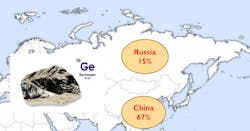Chalcogenide glass gears up for infrared imaging
From mass COVID fever-screening devices and sophisticated medical diagnostics to night-vision goggles and heat-seeking missiles, infrared (IR) imaging systems perform routine and critical military and commercial tasks. With thermal cameras now integrated into ruggedized smartphones, firefighters deploying imagers to find survivors in smoke-filled rooms and technology startups racing to create driverless cars, extending our vision to longer wavelengths is an integral part of life in the 21st century.
Capturing an IR picture requires a detector and optical elements to focus rays onto the detector, just like visible-light photography. Increasingly, imaging systems work in multiple spectral bands, including shortwave-infrared (SWIR), midwave-infrared (MWIR), and longwave-infrared (LWIR)—encompassing wavelengths from 0.9 to 15 μm.
However, the development of optical materials for IR lens elements has not kept pace with the explosion of detector technology or the soaring demand in the microbolometer market. The crown and flint glasses used in visible light optical components don’t serve the thermal regime well. An old standby, germanium, still works in some IR imaging applications, but the U.S. supply of the elemental semiconductor is subject to potential geopolitical and economic snags.
Innovative amorphous glasses based on the members of the chalcogen family of elements could provide IR imaging systems with improved performance, less weight, and a more reliable supply chain. However, U.S. government agencies and industries must work together to accelerate and foster a changeover to chalcogenide glasses.
Germanium: Pros and cons
With a high refractive index and transmission range from 1.8 to 17 μm, the crystalline semiconductor germanium forms the front lenses of most thermal (8–14 μm) imaging systems. It naturally blocks ultraviolet and visible light and scientists have studied its physical and chemical properties extensively since its late-19th century discovery, when it filled in a gap in the developing periodic table.
An element in the same periodic-table group as carbon and silicon, germanium got its first starring role in the early days of transistors. But since the 1970s, optical-fiber communications and night-vision optics have consumed a greater share of the germanium market—up to 85% in 2000. Optical-grade germanium is an n-type semiconductor with resistivity between 5 and 40 Ω-cm.1
Because of the high refractive index, the lenses and windows made from germanium usually require antireflective coating. For outdoor applications, the front surface of these optical elements may also require a hard protective coating—for example, a diamond-like carbon (DLC) or similar..
Though germanium has been a workhorse of IR imaging for more than 40 years, using that semiconductor presents pitfalls researchers must consider. At 5.32 g/cm3 at room temperature, germanium is more than twice as dense as silicon, so engineers may think twice about using it in equipment that needs to be lightweight. It’s impractical to fabricate optical components greater than 300 mm in diameter. Above 100°C, germanium experiences “thermal runaway,” meaning its absorption increases precipitously; around 200°C, it’s completely opaque.
Humans and their politics are the biggest drawback to germanium-based IR optical components. The U.S. has very little native stores of germanium and imports 95% of the element, mostly from China and Russia (see Fig. 1).2 The germanium supply chain is vulnerable to international political disputes and disruptions by the COVID-19 pandemic. The price of germanium on the world market increased by 104% between 2009 and 2014. The average price for germanium metal in 2021 was $1200 per kilogram, according to the U.S. Geological Survey’s mineral commodity summary.3
Both the U.S. Geological Survey and the U.S. Defense Department consider germanium a critical mineral, but Earth’s supplies of it are finite and not under U.S. control. New detection technologies exist across the IR spectral region, yet can’t be used in IR imaging if lenses are missing.
Chalcogenide glass for IR optics
Chalcogenide glasses are amorphous, covalently bonded compounds containing one or more of three elements: sulfur, selenium, and tellurium. Many chalcogenides also contain other elements such as arsenic, antimony, and even germanium (the latter makes a glass compound pricier).
Like pure germanium, synthetic chalcogenide glasses have high refractive indices. But unlike the brittle semiconductor, they can be precisely molded to specification rather than built up with crystal growth processes. Because thermal history alters glass properties, a lens made with chalcogenide glass may have a slightly different index of refraction from a raw chunk of the material.4 The rate at which refractive index changes with temperature, known as the thermo-optic coefficient or dn/dT, is much lower for glasses than for germanium.
Most chalcogenide glasses can transmit the three most important IR bands: SWIR, MWIR, and LWIR (thermal). But they pass little or no visible light, so they look like opaque materials to the naked eye. Manufacturers can tweak the properties of chalcogenide glasses during production to make customized materials for different uses. Research continues in this area.
Depending on the application, optical designers can incorporate both germanium and chalcogenide glass into an optomechanical system. In a simple example, a three-element lens system for high-performance thermography consists of a chalcogenide aspheric element sandwiched between two spherical germanium lenses.5 Such a design results in an athermalized system with an operating range from -40° to 85°C. Even more streamlined is an MWIR/LWIR continuous-zoom lens that requires 21 separate elements when built with only germanium components, but only 12 elements when designed with a combination of chalcogenide materials.6
With expansion of use of chalcogenide glasses into security and sensing applications, glass compositions that support multi- or broadband systems will have an advantage, according to Kathleen Richardson, Pegasus Professor of optics and materials science and engineering at the University of Central Florida. She says these materials will need to support a diverse range of manufacturing methods as platforms for the glass’s use and will require operation in a range of environments.
Most significantly for the economics of the IR imaging industry, the elements that make up chalcogenide glasses are produced in multiple countries, including the U.S. The supply chain for these ingredients is more stable, with far less price volatility than germanium.
Applications for chalcogenide glass lenses
Increasingly, scientists are turning to multispectral and hyperspectral imaging to expand beyond the narrow range of visible light. Multispectral systems collect from three to 15 wavelength bands, while hyperspectral instruments capture dozens to hundreds of narrow bands tailored to the desired information.
These imaging modalities with advanced detectors are finding their way into a variety of military and civilian applications, including ballistic missile detection, space-based climate assessment, agricultural crop monitoring, and biomedical equipment. Autonomous cars and trucks will need to “see” in multiple wavelengths to distinguish between clear roads, animals, buildings, pedestrians, and other vehicles and to see through darkness, rain, fog, and snow.
Many of these applications make use of multi-aperture payloads to accommodate the different lens needs of the sensors. But the ever-growing needs for portability and miniaturization—from tiny CubeSats piggybacking onto space-bound rockets to medical probes for surgery—will drive the demand for lens paths that can handle multiple wavelength bands.
LightPath Technologies’ chalcogenide-based lens enables a lightweight COTS lens assembly supporting low SWaP for our Athena1920 full high-definition, uncooled LWIR sensor, according to Laura Ferrante, director of thermal sensors business development for BAE Systems.
Chalcogenide glass: The road ahead
Several chalcogenide glasses are already in the U.S. marketplace, although the early glasses contain some level of germanium, with all its price volatility and supply-chain issues.
One lower-cost alternative to germanium-blend glasses is BD6, made solely of arsenic and selenium (As40Se60). BD6 and its equivalents produced by several U.S., Chinese, and German manufacturers transmit more than 97% of light across all IR bands, and its density of 4.63 g/cm3 gives it an advantage in aerospace and transportation.7 BD6’s U.S. maker, LightPath, uses the glass to manufacture molded lenses, diamond-turned lenses, and conventionally polished optics (see Fig. 2). The company has licensed additional compositions from the U.S. Naval Research Laboratory and is readying them for production work.
Chalcogenides, especially the family of IR glasses LightPath is planning to bring to market, open up the design space for optical engineers enabling innovative solutions, solving difficult requirements ranging from passive athermalized IR systems to multispectral applications, according to Bob Chipper, a senior engineering fellow with Raytheon Technologies. And he says the potential molding process for these IR glasses can address lower-cost and higher-volume applications.
Richardson believes our community needs to consider how chalcogenides can, in most instances, meet the needs or surpass the performance previously supported only by crystalline materials. With their compositional tunability and suitability as optical glass ceramics, gradient-index (GRIN) media, they can provide viable options for planar photonic sensing and imaging systems including variable field-of-view designs possible with optical phase-change materials.
The optics community still needs to do much more work—compile technical and statistical data, develop new optical coatings, and qualify materials for aerospace applications—before the latest chalcogenide glasses replace germanium. Germanium has a track record dating back more than 60 years, so design engineers may need some encouragement to buy into the new technology. The industry needs government involvement to accelerate U.S. chalcogenide manufacturing capacity, which stands at 10 metric tons annually for BD6, and to encourage adoption of the new glasses.
With the right economic support and development, chalcogenide optical elements are poised to improve IR imaging in all bands over the next decade.
REFERENCES
1. A. Symmons and M. Lifshotz, “Field Guide to Infrared Optical Materials,” SPIE Field Guides, FG49, 42 (2021).
2. W. C. P. Shanks III et al., “Germanium and indium,” U.S. Geological Survey Professional Paper 1802, I1–I27 (2017); https://doi.org/10.3133/pp1802I.
3. See https://pubs.usgs.gov/periodicals/mcs2022/mcs2022-germanium.pdf.
4. A. Symmons and M. Lifshotz, p. 104.
5. G. Cogburn, Proc. SPIE, 8189, 818911 (Oct. 19, 2011); https://doi.org/10.1117/12.897757.
6. J. L. Ramsey et al., Proc. SPIE, 10998, 109980M (May 14, 2019); https://doi.org/10.1117/12.2517801.
7. A. Locke, A. Symmons, and M. Lifshotz, Laser Focus World, 54, 11, 47–48 (Nov. 1, 2018); www.laserfocusworld.com/16555222.
Related Podcast
About the Author
Sam Rubin
President and CEO, LightPath Technologies
Sam Rubin is president and CEO of LightPath Technologies (Orlando, FL).
Mark Palvino
VP of Global Sales and Marketing, LightPath Technologies
Mark Palvino is vice president of global sales and marketing at LightPath Technologies (Orlando, FL).


